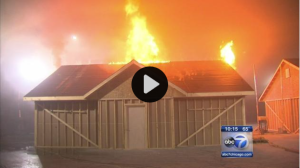What better day than New Year’s Eve to pop open a bottle of champagne (or its non-French sibling, sparkling wine)? Great thought, but turns out there’s a right way to open a bottle of bubbly, and “pop” has nothing to do with it.

A study claims that 900,000 injuries per year result from champagne. Injuries typically result from corks hitting faces, especially eyes. The pressure inside a bottle of champagne can be as high as 90 pounds per square inch, resulting in a cork traveling at speeds of up to 50 miles an hour. Injuries resulting from slips on spilled champagne also fall into this category.
Both spills and flying corks can be prevented by using a proper procedure to open a bottle of champagne. The preparation starts far before the party does. The first step is to ensure that the champagne is cooled properly. This is not only for taste, but also for safety. Another study found that cooling the bottle to 39 degrees F (4 degrees C) reduces the speed at which the cork leaves the bottle. (The cork travels only 3/4 of the speed of that from a room temperature, or 64 degrees F, bottle.)
Once you’re ready to serve the champagne, grab the bottle, glasses, and a kitchen towel. Check to see if there’s a tab on the foil covering the neck. If not, you’ll also need a knife. (One thing you won’t need? A corkscrew.) Remove the foil from the neck, by pulling the tab if one is present or by cutting with a knife, and then peeling it off. From this point until you start pouring, keep the bottle pointed at a 45 degree angle, and away from people, breakable objects, walls and ceilings. Untwist the wire tab, or key, and remove the wire cage, and hold your thumb over the cork. Cover the cork and neck of the bottle with the kitchen towel, and grab both the towel and cork with one hand. With the other hand, gently and slowly twist the bottle until the cork slides out. (This will be not with a pop, but more of a whimper.) Do not shake the bottle!
Hold champagne flutes at an angle and pour champagne in on the side to preserve the bubbles. Repeat as necessary. If you’ll need to leave the location at which you are drinking, please do it as a passenger, or wait until you’ve sobered up. For an average person, that means waiting about an hour for every 5 ounces of wine/ champagne consumed. (The drink size of other kinds of alcohol is defined differently, and your weight will impact the time it takes for alcohol to leave your system.)
If you or someone else forgets these rules and ends up getting hit in or near the eye with a champagne cork, take a trip to the ophthalmologist right away. (Because it’s New Year’s Eve, you may have to hit the emergency room first.) Says ophthalmologist Andrew Iwach, MD, “The good news is that as long as we can see these patients in a timely fashion, then there’s so many things we can do to help these patients preserve their vision.”
To view a visual diagram of the proper champagne-opening procedure, click on “Download PDF” above.










